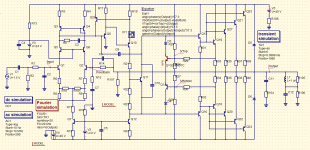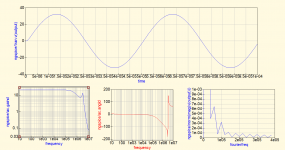Plenty of Exicon Lateral MOSFETs are still listed as active at the Profusion website:
Lateral MOSFETs (Buy Online) | Profusion
Lateral MOSFETs (Buy Online) | Profusion
If MOSFETs that can handle 50 V or so at reasonable current levels should become unavailable, maybe we have to start putting step-up transformers at the outputs of class B MOSFET amplifiers, or use stacked cascodes. I knew someone who used stacked cascodes for a direct-drive amplifier for electrostatic loudspeakers, you could do the same to drive dynamic loudspeakers with MOSFETs that can only handle a few volts.
There is one domain where you'll always find high power linear transistors: RF.
Of course, the price is a bit... spicy.
My RF engineer stomach says TO-247 may go up to short wave, but not any further.
I knew someone who used stacked cascodes for a direct-drive amplifier for electrostatic loudspeakers, you could do the same to drive dynamic loudspeakers with MOSFETs that can only handle a few volts.
With a few volts Vds there is a huge increase in capacitance so it gets pretty slow, on the other hand there are some pretty good low voltage high current high fT bipolars...
My RF engineer stomach says TO-247 may go up to short wave, but not any further.
Well almost, the MRF300 can go up to 250 MHz @ 300 W.
https://www.nxp.com/docs/en/data-sheet/MRF300AN.pdf
At $40 a piece or so, you won't probably be finding them in audio amplifiers soon.
This thread has explained to me why Creek dropped mosfet output designs and got a reputation for blown outputs.
Thanks for the information concerning the spirito effect. It is funny, that MOSFETs are still advertised as "free from second breakdown".
How stable are the IRFP240 and IRFP9240. Are they still used in commercial amplifiers and are the Exicons still used in commercial designs?
How stable are the IRFP240 and IRFP9240. Are they still used in commercial amplifiers and are the Exicons still used in commercial designs?
Newer manufacture of the old parts have Spirito badly, they are cheating using the old part number really.How stable are the IRFP240 and IRFP9240. Are they still used in commercial amplifiers and are the Exicons still used in commercial designs?
edit The IR pdfs SOAR only go down to 10ms, hiding the bad news
I don't see many recent commercial designs using vertical mosfets.
I still see new products using laterals
Most current products are using ICs or bipolar
Last edited:
are the Exicons still used in commercial designs?
If Profusion have over 1,000 pieces in stock, then I don't see why they wouldn't be used by smaller OEMs (assuming they buy half for storage to service amps in future, which would be highly conservative for laterals, as they are seriously tough and tend to go on for decades without hassle). How many 'large' OEMs are making dedicated power amps these days, anyway?
Don't be surprised if one of the larger independent OEMs sees this thread and plunders Profusion's stock... Seen it happen, many times (assuming the stock won't be replaced, which hopefully is not the case).
I have 4 amps fitted with Exicon laterals (the 20A variant). They were made over 20 years ago. I often run them well into class A @ 65-degrees C. Some of the VAS parts have failed, but the laterals have been rock-solid.
Last edited:
You don't know how much worse hot spotting gets with time, due to metal migration and diffusion effects.
A silicon semiconductor can survive local hotpots of 200C or more once, but not again and again for years
A silicon semiconductor can survive local hotpots of 200C or more once, but not again and again for years
What about wrapping each transistor in its own feedback loop like QSC powerlite series? (see attachment)
Helps against the effect of thermal impedances between devices, but not against thermal impedances inside a single transistor. The SOAR curves already assume that the ID of an MOSFET is somehow kept constant.
I have 4 amps fitted with Exicon laterals (the 20A variant). They were made over 20 years ago. I often run them well into class A @ 65-degrees C. Some of the VAS parts have failed, but the laterals have been rock-solid.
I realize that future designs may not be able to get all of the best, most exotic transistors and tried to make a future proofed design. I have used MJE15032/MJE15033 for both VAS and driver for this reason, because the transistor seems to be fast enough for VAS and can take more quiescent heat, even though MJE15032/MJE15032 is an unconventional VAS choice. I put this into my amp project
GitHub - profdc9/PowerAmpAudio: Power Amplifier based on Michael Chua's C300 amplifier
I am trying to use the fewest number of types of transistors to future proof the design. I use only 2N5551/2N5401 (or MPSA42/MPSA92) which still seem to have many cheap copies made, a medium power transistor for VAS/driver (MJE15032/MJE15033 or MJE340/MJE350) and a high power transistor for output stage (MJL3281/MJL1302 or 2SC5200/2SA1943). It wouldn't be the fastest, but for less than 100 V rail-to-rail, one could substitute TIP41/TIP42 and TIP3055/TIP2955 if there were no other available faster parts.
Just out of curiosity, I modified my amp project to use only 2N5551/2N5401 and TIP41/TIP42. The simulated results are better than I thought they would be. It delivers 135 W into a 4 ohm load with 0.06% distortion at 20 kHz.
The VAS transistors Q10/Q12, the buffer transistors Q15/Q16 and the output transistors Q18-Q27 are all TIP41C/42C.
The VAS transistors Q10/Q12, the buffer transistors Q15/Q16 and the output transistors Q18-Q27 are all TIP41C/42C.
Attachments
Hello,
Well, class D is far more efficient, runs cooler and when done well (of course there is junk as well as good implementations), gives real top quality class A a contest in terms of quality. And mostly cheaper than top quality class A designs with much better control of the woofer, for the most part.
What is not to like? Pretty likely it will be completely dominate in a few more years. IMHO.
There will always be some who prefer their favorite type, and that is fine. IE: The Model T Ford still has devotees who spend their money on their desire.
Regards,
Greg
Well, class D is far more efficient, runs cooler and when done well (of course there is junk as well as good implementations), gives real top quality class A a contest in terms of quality. And mostly cheaper than top quality class A designs with much better control of the woofer, for the most part.
What is not to like? Pretty likely it will be completely dominate in a few more years. IMHO.
There will always be some who prefer their favorite type, and that is fine. IE: The Model T Ford still has devotees who spend their money on their desire.
Regards,
Greg
I realize that future designs may not be able to get all of the best, most exotic transistors and tried to make a future proofed design.
When I designed my MOSFET amplifier in 1994, I used the cheapest and most common MOSFETs available (BUZ10), the very common CA3046 transistor arrays that you could buy in any parts shop and for the rest the cheap and common BC546...BC550 and BC556...BC560 transistors. The MOSFETs and transistor arrays are nowhere to be found anymore and it's getting difficult to find non-SMD versions of the rest.
> its own feedback loop like QSC powerlite
This does not help with 2nd breakdown; the paper is 1998 and in those days they could still buy beefy-junction parts.
The little feedback loop to enforce threshold idea has been around a while. I was doing it a few years later (not from peeking in QSC boxes or papers). The first problem is stability, any such scheme wants to sing MHz, at idle or at specific conduction levels. The simple fix is a slug of capacitance, which does not always work well, and dents overall speed.
This does not help with 2nd breakdown; the paper is 1998 and in those days they could still buy beefy-junction parts.
The little feedback loop to enforce threshold idea has been around a while. I was doing it a few years later (not from peeking in QSC boxes or papers). The first problem is stability, any such scheme wants to sing MHz, at idle or at specific conduction levels. The simple fix is a slug of capacitance, which does not always work well, and dents overall speed.
- Home
- Design & Build
- Parts
- Class AB "endangered"?

